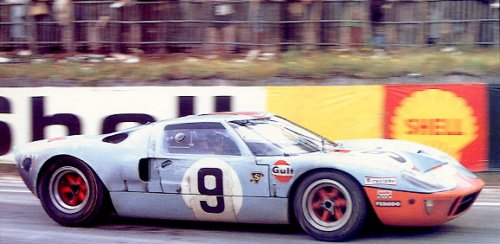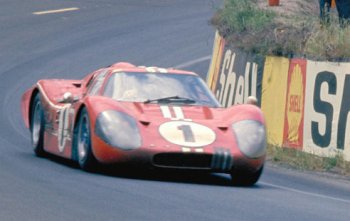Attempting to tell the story of the Ford GT40 in a few short pages would be much like recounting the tale of the Porsche 935. The GT40 evolved over time and came in many guises. GT40s triumphed at Le Mans on four occasions, famously beating the likes of Ferrari at their own game.
But rather than the works-ran Mk II and Mk IV cars that won in 1966 and 1967, the most famous of the breed were the blue and orange JWA cars which claimed victory in both 1968 and 1969, an example of which is shown above.
Origins of the GT40
The GT40, so named because of its 40" height, came into being as the result of a desire of the Ford Motor Company to expand its racing horizons and to triumph in the field of endurance sports car racing. This decision was taken in 1963 by which time Le Mans had thoroughly captured the imagination of the American public.
Initially, Ford approached Enzo Ferrari with a view to buying a stake in the company, which would be renamed 'Ford-Ferrari'. During negotiations, Ferrari became disillusioned with the levels of red tape and bureaucracy in his dealings with the corporation. He was a racing man who saw road cars as a means of financing the Ferrari racing operation and felt that big business-style practices would cripple the racing effort. Negotiations quickly floundered.
Ford then decided to set up its own autonomous racing arm to build a Le Mans contender. England was chosen as the home for this unit, which was named Special Vehicle Operations and based in Slough, close to Heathrow airport. Amongst the staff brought in to run the operation was John Wyer.
The GT40 was conceptualised and a full-scale clay model built back in the United States in Dearborn, Michigan. The clay model was then shipped to England for the development and construction phase. Famously, on completion in April 1964, the very first prototype (GT/101) was press-launched at Heathrow Airport and shipped overnight to New York for presentation to the US public at the Essex House Hotel. The car was then flown back to England for race preparation and was tested a week later at MIRA proving grounds in the Midlands and then at Silverstone circuit on April 16th 1964.
In its first racing season, the car proved to be far from reliable and retired from every race in which it took part. Back in the US, Carroll Shelby was contacted to take over the racing operation for 1965 with Special Vehicle Operations in Slough (now renamed FAV for Ford Advanced Vehicles) left to concentrate on building the cars. At the first race of the year, the Daytona 2000 Km in February, the GT triumphed and so vanquished its 100% unreliability record.
The rest of the season was slightly more disappointing. The car was blindingly good but just did not seem to have the reliability for longer distance races. As a solution, a larger 7 litre engined Mark II version was built for 1966 and, finally, the GT40 claimed a 1-2-3 victory at Le Mans with Bruce mcLaren and Chris Amon in the lead car. The following year (1967), twelve GTs took part in a variety of guises including four heavily modified Mark IVs, which took a first (in the hands of Dan Gurney and A. J. Foyt) and fourth place. None of the earlier versions finished.
|

